Do you have a question about the Panasonic Viera TX-P42G30E and is the answer not in the manual?
Provides model numbers and a welcome message for the Panasonic Plasma Television.
Illustrates connections for multimedia devices like networks, SD cards, USB devices, etc.
Provides important notices regarding DVB-T, DVB-C, and IPTV functions.
Details essential safety guidelines for handling the TV, plug, moisture, and ventilation.
Provides guidance on cleaning the display, cabinet, pedestal, and mains plug.
Covers precautions related to heat, moisture, ventilation, volume, force, and handling weight.
Lists standard included accessories and optional accessories available for purchase.
Instructions for correctly installing batteries in the remote control.
Step-by-step guide for attaching the TV pedestal, including warnings.
Details on assembling the pedestal and securely attaching the TV.
Instructions for adjusting the viewing angle of the TV screen.
Identifies and describes the functions of each button on the remote control.
Identifies and describes the various terminals on the TV.
Explains on-screen display operation and the auto standby function.
Illustrates connecting aerials and external video equipment like DVD recorders.
Provides instructions for securely connecting the TV's mains lead.
Shows connections for DVD recorders, VCRs, and set-top boxes.
Details how to connect the TV to a network environment via wired or wireless.
Guides through the automatic TV channel search and setup process.
Covers DVB network settings and auto setup for DVB-C, DVB-T, and Analogue channels.
Details the steps for establishing a wired network connection.
Guides through selecting access points, entering encryption keys, and testing connections.
Covers WPS setup and selecting the Home or Shop viewing environment.
Explains how to access and navigate the VIERA Connect internet service.
Guides on selecting TV modes and various methods for choosing channels.
Details the display information banner and its available messages.
Explains how to display or hide subtitles and change language.
Covers the Hold function for picture freezing and other selectable settings.
Details how to set the Off Timer to automatically turn the TV off.
Manual adjustment of the image aspect ratio for optimal viewing.
Allows easy switching between previously viewed channels or input modes.
Explains the TV Guide (EPG) and how to view it by channel or time.
Details how to navigate the TV Guide by day, channel type, and category.
Provides information on how to view advertisements within the TV Guide system.
Guides on setting, checking, changing, and cancelling timer programming events.
Explains teletext modes (FLOF, TOP, List) and basic page selection.
Covers multi-window viewing, storing pages, viewing sub pages, and update watching.
Guides on connecting external equipment and selecting the input source.
Explains operating connected equipment with the TV remote and changing codes.
Details how to access and use various special features via VIERA TOOLS.
Guides on displaying, selecting menus, items, and using slide bars.
Provides descriptions for various Viewing Modes like Dynamic, Cinema, THX, and Game.
Covers settings like Eco Mode, P-NR, 3D-COMB, and screen display options.
Details DVI input, Pixel Orbiter, Scrolling Bar, and basic sound adjustments.
Covers speaker distance, MPX, SPDIF, HDMI input, and timer functions.
Covers system, DVB-C, Analogue tuning, language, and display settings.
Details DVB-T/Analogue tuning, language preferences, and teletext settings.
Covers teletext display modes, character sets, default guide, and input labels.
Covers display timeout, system updates, network setup, and DivX VOD.
Includes USB keyboard, shipping condition, GUIDE Plus+ settings, and time zone.
Guides on performing automatic channel search for DVB-C reception.
Guides on performing automatic channel search for DVB-T and Analogue reception.
Explains how to access channel tuning menus and functions like Favourites Edit.
Guides on creating and managing favourite channel lists.
Details on editing favourites, skipping channels, and managing the channel list.
Covers manual tuning, updating channel lists, and new channel messages.
Explains how to check DVB signal quality and reduce signal strength.
Guides on accessing analogue tuning options and skipping channels.
Details on retuning, moving channel positions, and renaming analogue channels.
Provides instructions for fine-tuning analogue channels.
Guides on accessing the timer programming menu and selecting modes.
Details on selecting recording/reminder function and entering event parameters.
Instructions for changing or cancelling timer programming events.
Guides on setting up the Child Lock feature for channel access control.
Details on locking channels/inputs and changing the PIN number.
Explains how to set parental rating restrictions for programmes.
Guides on accessing input label settings and naming input terminals.
Details CI module installation, cautions, and accessing common interface services.
Guides on resetting the TV to its original factory condition.
Explains how to update the TV's software automatically or manually.
Guides on accessing and adjusting advanced picture settings.
Details on locking picture settings using a PIN number.
Covers detailed adjustments for white balance, colour management, and gamma.
Explains how to copy advanced picture settings to other inputs.
Guides on connecting the USB HDD and setting it up for recording.
Details on navigating the menu to access the recording setup options.
Guides on selecting the USB HDD, confirming usage, and handling cautions.
Details on naming the USB HDD and enabling it for recording.
Instructions for recording the current programme instantly.
Guides on how to record the current programme constantly using REW LIVE TV.
Covers starting, stopping, and operating One Touch Recording and REW LIVE TV.
Introduces the Media Player and how to insert/remove storage devices.
Guides on starting the Media Player, selecting devices, and content types.
Covers thumbnail display, photo information, and changing thumbnail size.
Guides on sorting photos by folder, date, or month and selecting groups.
Details single photo view, slideshow playback, and related controls.
Guides on setting up slideshow parameters like frame, colour, and interval.
Details frame types and colour effects available for slideshows.
Covers transition effects, screen modes, burst playback, and interval settings.
Guides on selecting background music for photo slideshows.
Explains how to switch between connected devices and content types.
Details video mode thumbnail display, scene selection, and playback.
Covers playback controls and video setup options like preview and repeat.
Explains how to confirm and change video status like multi-audio and aspect.
Guides on playing, editing (grouping, protection), and deleting recorded TV content.
Covers playback operations and switching between media devices.
Explains how to start playback from the chapter list.
Details audio output settings for multi-channel sound via HDMI or digital audio out.
Guides on playing music files from folders in the SD Card or USB Flash Memory.
Covers playback of music files via file view and playback operations.
Details music setup options like repeat and background music.
Introduces DLNA standards and using PCs or DIGA Recorders as media servers.
Explains VIERA Connect as a gateway to internet services.
Illustrates wired and wireless network connection setups.
Shows direct connection examples for DLNA and VIERA Connect.
Guides on setting up network connections for the TV.
Details settings for controlling the TV from network equipment.
Covers setting network type to wired and configuring IP/DNS settings.
Details on setting up proxy address and port number.
Guides on selecting connection type (WPS, Search) for wireless setup.
Covers setting access point details and confirming connection status.
Guides on performing a connection test to verify network connectivity.
Explains WPS Push Button and WPS PIN connection methods.
Details manual setup of SSID, authentication, encryption key.
Guides on updating the TV software automatically or manually.
Guides on displaying media server icons and selecting a server.
Details on selecting and playing files from DLNA media servers.
Covers playback operations for photo and video files.
Details music file playback operations.
Explains how to control a DIGA Recorder and its option menus.
Covers setup options for slideshows, video, and music playback.
Details VIERA Connect customization like home screen, account, and lock settings.
Explains audio output settings for video content, including SPDIF selection.
Summarizes Q-Link features for connecting DVD recorders/VCRs.
Summarizes VIERA Link features for connecting various equipment.
Details HDMI and Audio out connections for VIERA Link.
Shows compatibility of VIERA Link Control with different equipment types.
Covers Q-Link preparations, preset download, and Direct TV Recording.
Details Direct TV Recording and power on/off link functions.
Guides on connecting equipment and setting up VIERA Link.
Explains features like preset download, easy playback, and power links.
Details standby power saving and intelligent auto standby functions.
Guides on performing Direct TV Recording and stopping recordings.
Instructions for pausing live TV, operating playback, and returning to live TV.
Guides on displaying the VIERA Link Menu and selecting VIERA Link Control.
Details on selecting the type of connected equipment to access.
Explains how to operate menus when multiple recorders or players are connected.
Guides on accessing menus of equipment not supporting VIERA Link.
Details how to control theatre speakers and select Home Cinema or TV speakers.
Guides on setting up multi-channel sound via an amplifier.
Shows a diagram of the TV's rear panel and connection ports.
Illustrates common connections for recording, satellite broadcasts, and DVDs.
Details wired network, USB devices, and ferrite core installation.
Covers camcorder, game equipment, and speaker connections.
Details headphone connection and volume adjustment.
Provides a table showing equipment compatibility with each TV terminal.
Explains the auto aspect ratio function for optimal screen filling.
Details how the TV handles Widescreen (WSS) and Control signals.
Lists supported photo file formats (JPEG) and their restrictions.
Lists supported video file formats (AVI, MKV, MP4, etc.) and their restrictions.
Lists supported music file formats (MP3, AAC, WMA) and their restrictions.
Details DivX video support, subtitle file formats, and VOD registration.
Details formats, capacities, and usage of SD Cards and USB Flash Memory.
Provides pinout information for SCART and HDMI terminals.
Explains HDMI features like audio signals, video signals, and VIERA Link.
Lists compatible input signals for COMPONENT, HDMI, and PC connections.
Details USB connection recommendations and device compatibility.
Explains USB keyboard and gamepad usage and character input methods.
Addresses issues like block noise, frozen images, and no picture.
Covers problems with no sound, connectivity, and VIERA Link errors.
Troubleshoots issues with recording not starting and reduced contrast.
Addresses specific screen issues (noisy, distorted) and sound problems.
Covers HDMI connection issues, network connectivity, and remote control problems.
Lists power source, consumption, dimensions, mass, and display panel details.
Details speaker, audio output, reception systems, and connection terminals.
Provides details on card slots, Ethernet, USB, and audio output terminals.
Lists trademarks and licence information for various technologies and software.
Provides information on the collection and disposal of old equipment and batteries.
Includes Declaration of Conformity and space for customer's purchase record.
Provides model numbers and a welcome message for the Panasonic Plasma Television.
Illustrates connections for multimedia devices like networks, SD cards, USB devices, etc.
Provides important notices regarding DVB-T, DVB-C, and IPTV functions.
Details essential safety guidelines for handling the TV, plug, moisture, and ventilation.
Provides guidance on cleaning the display, cabinet, pedestal, and mains plug.
Covers precautions related to heat, moisture, ventilation, volume, force, and handling weight.
Lists standard included accessories and optional accessories available for purchase.
Instructions for correctly installing batteries in the remote control.
Step-by-step guide for attaching the TV pedestal, including warnings.
Details on assembling the pedestal and securely attaching the TV.
Instructions for adjusting the viewing angle of the TV screen.
Identifies and describes the functions of each button on the remote control.
Identifies and describes the various terminals on the TV.
Explains on-screen display operation and the auto standby function.
Illustrates connecting aerials and external video equipment like DVD recorders.
Provides instructions for securely connecting the TV's mains lead.
Shows connections for DVD recorders, VCRs, and set-top boxes.
Details how to connect the TV to a network environment via wired or wireless.
Guides through the automatic TV channel search and setup process.
Covers DVB network settings and auto setup for DVB-C, DVB-T, and Analogue channels.
Details the steps for establishing a wired network connection.
Guides through selecting access points, entering encryption keys, and testing connections.
Covers WPS setup and selecting the Home or Shop viewing environment.
Explains how to access and navigate the VIERA Connect internet service.
Guides on selecting TV modes and various methods for choosing channels.
Details the display information banner and its available messages.
Explains how to display or hide subtitles and change language.
Covers the Hold function for picture freezing and other selectable settings.
Details how to set the Off Timer to automatically turn the TV off.
Manual adjustment of the image aspect ratio for optimal viewing.
Allows easy switching between previously viewed channels or input modes.
Explains the TV Guide (EPG) and how to view it by channel or time.
Details how to navigate the TV Guide by day, channel type, and category.
Provides information on how to view advertisements within the TV Guide system.
Guides on setting, checking, changing, and cancelling timer programming events.
Explains teletext modes (FLOF, TOP, List) and basic page selection.
Covers multi-window viewing, storing pages, viewing sub pages, and update watching.
Guides on connecting external equipment and selecting the input source.
Explains operating connected equipment with the TV remote and changing codes.
Details how to access and use various special features via VIERA TOOLS.
Guides on displaying, selecting menus, items, and using slide bars.
Provides descriptions for various Viewing Modes like Dynamic, Cinema, THX, and Game.
Covers settings like Eco Mode, P-NR, 3D-COMB, and screen display options.
Details DVI input, Pixel Orbiter, Scrolling Bar, and basic sound adjustments.
Covers speaker distance, MPX, SPDIF, HDMI input, and timer functions.
Covers system, DVB-C, Analogue tuning, language, and display settings.
Details DVB-T/Analogue tuning, language preferences, and teletext settings.
Covers teletext display modes, character sets, default guide, and input labels.
Covers display timeout, system updates, network setup, and DivX VOD.
Includes USB keyboard, shipping condition, GUIDE Plus+ settings, and time zone.
Guides on performing automatic channel search for DVB-C reception.
Guides on performing automatic channel search for DVB-T and Analogue reception.
Explains how to access channel tuning menus and functions like Favourites Edit.
Guides on creating and managing favourite channel lists.
Details on editing favourites, skipping channels, and managing the channel list.
Covers manual tuning, updating channel lists, and new channel messages.
Explains how to check DVB signal quality and reduce signal strength.
Guides on accessing analogue tuning options and skipping channels.
Details on retuning, moving channel positions, and renaming analogue channels.
Provides instructions for fine-tuning analogue channels.
Guides on accessing the timer programming menu and selecting modes.
Details on selecting recording/reminder function and entering event parameters.
Instructions for changing or cancelling timer programming events.
Guides on setting up the Child Lock feature for channel access control.
Details on locking channels/inputs and changing the PIN number.
Explains how to set parental rating restrictions for programmes.
Guides on accessing input label settings and naming input terminals.
Details CI module installation, cautions, and accessing common interface services.
Guides on resetting the TV to its original factory condition.
Explains how to update the TV's software automatically or manually.
Guides on accessing and adjusting advanced picture settings.
Details on locking picture settings using a PIN number.
Covers detailed adjustments for white balance, colour management, and gamma.
Explains how to copy advanced picture settings to other inputs.
Guides on connecting the USB HDD and setting it up for recording.
Details on navigating the menu to access the recording setup options.
Guides on selecting the USB HDD, confirming usage, and handling cautions.
Details on naming the USB HDD and enabling it for recording.
Instructions for recording the current programme instantly.
Guides on how to record the current programme constantly using REW LIVE TV.
Covers starting, stopping, and operating One Touch Recording and REW LIVE TV.
Introduces the Media Player and how to insert/remove storage devices.
Guides on starting the Media Player, selecting devices, and content types.
Covers thumbnail display, photo information, and changing thumbnail size.
Guides on sorting photos by folder, date, or month and selecting groups.
Details single photo view, slideshow playback, and related controls.
Guides on setting up slideshow parameters like frame, colour, and interval.
Details frame types and colour effects available for slideshows.
Covers transition effects, screen modes, burst playback, and interval settings.
Guides on selecting background music for photo slideshows.
Explains how to switch between connected devices and content types.
Details video mode thumbnail display, scene selection, and playback.
Covers playback controls and video setup options like preview and repeat.
Explains how to confirm and change video status like multi-audio and aspect.
Guides on playing, editing (grouping, protection), and deleting recorded TV content.
Covers playback operations and switching between media devices.
Explains how to start playback from the chapter list.
Details audio output settings for multi-channel sound via HDMI or digital audio out.
Guides on playing music files from folders in the SD Card or USB Flash Memory.
Covers playback of music files via file view and playback operations.
Details music setup options like repeat and background music.
Introduces DLNA standards and using PCs or DIGA Recorders as media servers.
Explains VIERA Connect as a gateway to internet services.
Illustrates wired and wireless network connection setups.
Shows direct connection examples for DLNA and VIERA Connect.
Guides on setting up network connections for the TV.
Details settings for controlling the TV from network equipment.
Covers setting network type to wired and configuring IP/DNS settings.
Details on setting up proxy address and port number.
Guides on selecting connection type (WPS, Search) for wireless setup.
Covers setting access point details and confirming connection status.
Guides on performing a connection test to verify network connectivity.
Explains WPS Push Button and WPS PIN connection methods.
Details manual setup of SSID, authentication, encryption key.
Guides on updating the TV software automatically or manually.
Guides on displaying media server icons and selecting a server.
Details on selecting and playing files from DLNA media servers.
Covers playback operations for photo and video files.
Details music file playback operations.
Explains how to control a DIGA Recorder and its option menus.
Covers setup options for slideshows, video, and music playback.
Details VIERA Connect customization like home screen, account, and lock settings.
Explains audio output settings for video content, including SPDIF selection.
Summarizes Q-Link features for connecting DVD recorders/VCRs.
Summarizes VIERA Link features for connecting various equipment.
Details HDMI and Audio out connections for VIERA Link.
Shows compatibility of VIERA Link Control with different equipment types.
Covers Q-Link preparations, preset download, and Direct TV Recording.
Details Direct TV Recording and power on/off link functions.
Guides on connecting equipment and setting up VIERA Link.
Explains features like preset download, easy playback, and power links.
Details standby power saving and intelligent auto standby functions.
Guides on performing Direct TV Recording and stopping recordings.
Instructions for pausing live TV, operating playback, and returning to live TV.
Guides on displaying the VIERA Link Menu and selecting VIERA Link Control.
Details on selecting the type of connected equipment to access.
Explains how to operate menus when multiple recorders or players are connected.
Guides on accessing menus of equipment not supporting VIERA Link.
Details how to control theatre speakers and select Home Cinema or TV speakers.
Guides on setting up multi-channel sound via an amplifier.
Shows a diagram of the TV's rear panel and connection ports.
Illustrates common connections for recording, satellite broadcasts, and DVDs.
Details wired network, USB devices, and ferrite core installation.
Covers camcorder, game equipment, and speaker connections.
Details headphone connection and volume adjustment.
Provides a table showing equipment compatibility with each TV terminal.
Explains the auto aspect ratio function for optimal screen filling.
Details how the TV handles Widescreen (WSS) and Control signals.
Lists supported photo file formats (JPEG) and their restrictions.
Lists supported video file formats (AVI, MKV, MP4, etc.) and their restrictions.
Lists supported music file formats (MP3, AAC, WMA) and their restrictions.
Details DivX video support, subtitle file formats, and VOD registration.
Details formats, capacities, and usage of SD Cards and USB Flash Memory.
Provides pinout information for SCART and HDMI terminals.
Explains HDMI features like audio signals, video signals, and VIERA Link.
Lists compatible input signals for COMPONENT, HDMI, and PC connections.
Details USB connection recommendations and device compatibility.
Explains USB keyboard and gamepad usage and character input methods.
Addresses issues like block noise, frozen images, and no picture.
Covers problems with no sound, connectivity, and VIERA Link errors.
Troubleshoots issues with recording not starting and reduced contrast.
Addresses specific screen issues (noisy, distorted) and sound problems.
Covers HDMI connection issues, network connectivity, and remote control problems.
Lists power source, consumption, dimensions, mass, and display panel details.
Details speaker, audio output, reception systems, and connection terminals.
Provides details on card slots, Ethernet, USB, and audio output terminals.
Lists trademarks and licence information for various technologies and software.
Provides information on the collection and disposal of old equipment and batteries.
Includes Declaration of Conformity and space for customer's purchase record.
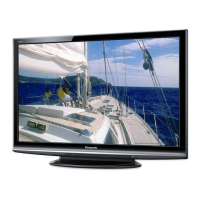


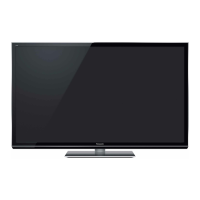
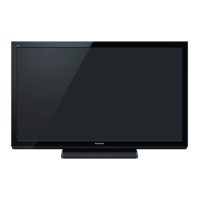

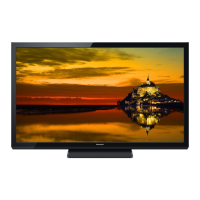
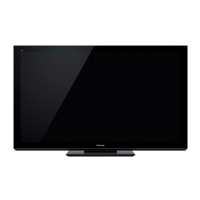
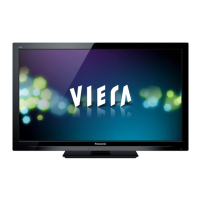
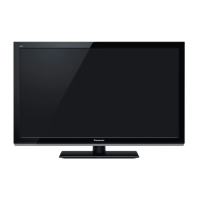
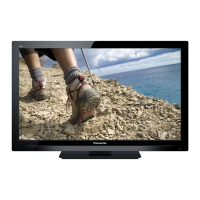
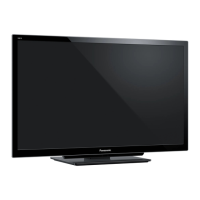
